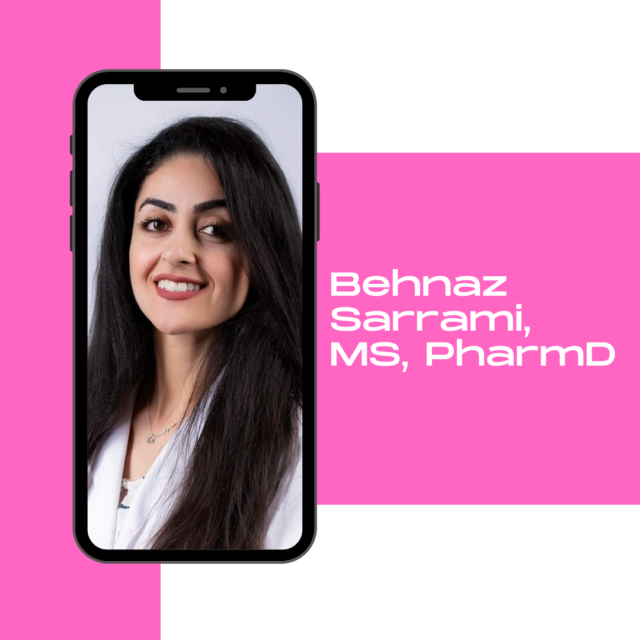Precision Medicine: Pharmacogenomics
Precision medicine is a treatment approach which takes into account the individual variability in genetics, environment and lifestyle for each person. Pharmacogenomics (PGx) plays an important role in precision medicine as it allows for personalization of an individual’s medications. I developed a deeper understanding of this concept when I began partnering with Washington University (St. Louis, MO) to do research focused on optimizing medication for older adults. My goal is to create a path and inspire other pharmacists to think outside the box and know they can do so much more with their Doctor of Pharmacy than they imagined. I hope my story will inspire others to explore a journey they may not think is possible.
Where the journey began
I was a single mom who just graduated from an on-line pharmacy program through Creighton University. I was working in a retail store to make ends meet. I wanted to set myself apart from others and find fulfillment in my work as a pharmacist. So, I got involved in research at Washington University visiting the homes of poor, medically underserved older adults providing Medication Therapy Management (MTM). After seeing numerous patients on the same medications but with different results, I wondered why the same medications worked differently in every person. After realizing that each person’s unique genetic variation determines their response to medications, my goal became to educate clinicians on the value and clinical utility of PGx. To that end, I started my own PGx consulting company (www.missouripgx.com) and got involved in grants with other healthcare professionals to bring more awareness to the value and clinical utility of PGx. I established a collaborative practice agreement within a psychiatric clinic providing MTM, Chronic Care Management (CCM) and PGx.
Coaching my pharmacist peers
I expanded my efforts further to teach my pharmacist peers how to start their own PGx consulting career. For this purpose, I implemented a one-to-one personalized coaching approach as I knew each pharmacist was in a different stage of their job and needed specific directions accordingly. The next step was to teach pharmacy students about the benefits of PGx. So, I created a PGx curriculum for St. Louis College of Pharmacy to offer to their students a PGx training rotation. This curriculum was the first of its kind for that pharmacy school. The possibilities became endless of the many ways, PGx can be incorporated and utilized to create what the mind can think of.
The road less traveled
Recently I ventured into other activities related to PGx, including PGx software consultant, speaking engagement, and hosting of PGx for Pharmacist Podcast, which has become one of the top 20 genomics podcasts globally! (PGX for Pharmacists on Apple Podcasts). I was happy to work with so many amazing pharmacists and for helping them start their own PGx career. I also wanted to make sure pharmacists would be the front and center of the clinical decisions creating a comprehensive medication action plan for their patients, in addition to knowing the business side.
Defining Precision Medicine
Understanding the true meaning of Precision Medicine is key to personalizing patient’s medications. So, let’s define the phrase “precision medicine.” Many factors affect how a medication works for a person, including age, kidney function, timing of a medication, social behavior, drug-drug interaction, phenoconversion, and PGx. Therefore, precision medicine includes all of those factors and PGx is just a piece of the puzzle that makes up the entire picture. Using only the PGx report is not enough to make a comprehensive clinical decision. Realizing that there is a unique patient behind the raw data and also clinically understanding the genetics interpretations behind each gene is key to precision medicine.
Timing of medications
Let’s look at some examples which illustrate that the timing of a medication is an essential factor in effectiveness of medications. Lurasidone (Latuda) should be taken with at least 350 calories to increase absorption. Synthroid is best to be taken on an empty stomach, preferably first thing in the morning at least 30 minutes before any food. The antibiotic ciprofloxacin if taken at the same time as dairy products or iron can decrease in absorption. Therefore, understanding the best time and how a medication should be taken is a key step in making sure it’s working as expected. Environmental factors and social behavior such as smoking (Cannabidiol Pathway, Pharmacokinetics (pharmgkb.org)) and alcohol, can also have a huge difference in the metabolism of a medication by inhibiting or inducing it. For example, smoking and ciprofloxacin can change the serum concentration levels of clozapine. (Clozapine Pathway, Pharmacokinetics (pharmgkb.org))
Phenoconversion: The blind spot of PGx
Another reason why PGx should not be used as face value is because of a concept called, the “blind spot of PGx”, or phenoconversion; Let me explain.
Some medications are already in their active form and some need to be activated. Medications are metabolized to become more water soluble or in a form that the body can excrete. Let’s take fluoxetine as an example. Fluoxetine is metabolized by CYP2D6 enzyme but it also inhibits its own metabolism. This is why it has a long half-life and stays in the body longer. Codeine is an inactive medication (prodrug) and uses the same CYP2D6 enzyme to activate and turn into morphine to have its pain relief effect. So, combining codeine and fluoxetine can create a problem: codeine needs CYP2D6 to activate and fluoxetine inhibits CYP2D6. Therefore, if a person is a normal metabolizer of CYP2D6 and is on codeine, the conversion to morphine happens without a problem. If we add Prozac, as an example, we can phenoconvert that person to a poor metabolizer of CYP2D6 and now they may no longer be able to convert codeine to morphine. This is the blind spot of PGx since it does not appear on a PGx report unless that algorithm is embedded in that platform or that we truly comprehend this idea and use our own clinical judgement.
PGx consulting: A new career path
Having a solid clinical knowledge in PGx is crucial to making the best clinical decisions for a patient. In addition to having a business mind set to be able to package oneself and better present to other clinicians. I believe I have created the path for my peers to start thinking of Pharmacogenomics and consulting as a career change. I have and will continue to pave the way for other pharmacists to take on this challenge with me to step outside their roles and use their amazing talents to recreate a business model for themselves and to get compensated for the many years of schooling, education, and experience they have gained. Pharmacists are under-utilized and it’s time that we show just how valuable our knowledge is in personalizing health.
In my current role as a Medical Science Liaison (MSL) for IDgenetix, my goal is clinical education for providers and guidance to interpreting their patient’s PGx report. It has been a long but exciting journey that only gets better. I hope pharmacists reading my story are inspired by the many possibilities that are out there for them especially if they want to step outside of their current role. Remember, every great vision starts with a thought and if that vision is not out there for you to be a part of, then create it!
Find what sparks a light in you so that in your own way you can illuminate the world. – Oprah Winfrey

Behnaz Sarrami, MS, PharmD
PGx Coach, MSL, Podcaster
Beh.sarrami@gmail.com

